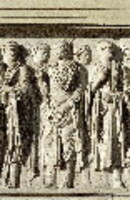| dc.coverage.spatial | Site: Rome, Lazio, Italy | en_US |
| dc.coverage.temporal | 13-9 BCE (creation); 1938 (restoration) | en_US |
| dc.creator | unknown (Ancient Roman sculptor) | en_US |
| dc.date | -13--9 | en_US |
| dc.date.accessioned | 2013-05-29T19:00:18Z | |
| dc.date.available | 2013-05-29T19:00:18Z | |
| dc.date.issued | -13--9 | en_US |
| dc.identifier | 222016 | en_US |
| dc.identifier.other | archrefid: 500 | en_US |
| dc.identifier.uri | http://hdl.handle.net/1721.3/129965 | |
| dc.description | Along the South Procession, frontal view of figures who follow Augusts, depicting in the center one of the flamines maiores (the three priests attached to the cult of the most important divinities: Jupiter, Mars and Quirini); Dedicated on 30 January 9 BCE, the altar was erected in the Campus Martius by the Roman Senate to commemorate Augustus' return from Spain and Gaul on 4 July 13 BCE. The best-known exemplar of Augustan art, it is typified by its eclectic mix of Classical and Hellenistic elements and skillful amalgam of Roman myth-history and contemporary events. Source: Grove Art Online; http://www.oxfordartonline.com/ (accessed 9/1/2009) | en_US |
| dc.format.medium | marble | en_US |
| dc.rights | © Scott Gilchrist, Archivision, Inc. | en_US |
| dc.subject | allegorical | en_US |
| dc.subject | mythology (Classical) | en_US |
| dc.subject | portraits | en_US |
| dc.subject | rulers and leaders | en_US |
| dc.subject | Augustus, Emperor of Rome, 63 B.C.-14 A.D. | en_US |
| dc.subject | Julio-Claudian dynasty | en_US |
| dc.subject | Imperial (Roman) | en_US |
| dc.title | Ara Pacis Augustae | en_US |
| dc.title.alternative | Altar of Augustan Peace | en_US |
| dc.title.alternative | Ara Pacis | en_US |
| dc.type | image | en_US |
| dc.rights.access | Licensed for educational and research use by the MIT community only | en_US |
| dc.identifier.vendorcode | 1A3-R-R-AP-3-B3 | en_US |
| vra.culturalContext | Ancient Roman | en_US |
| vra.technique | construction (assembling) carving (processes) | en_US |
| vra.worktype | monument | en_US |
| vra.worktype | relief (sculpture) | en_US |
| dc.contributor.display | unknown (Ancient Roman sculptor) | en_US |



